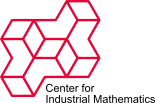Projects of Former WG Modelling and PDEs
 Multi-Mechanism Models: Theory and its Application to some Phenomena in the Material Behavior of Steel
Multi-Mechanism Models: Theory and its Application to some Phenomena in the Material Behavior of SteelA major problem in the modeling of complex material behaviour is that the material laws can be complicated if multiple inelastic effects are treated as "one mechanism". Another alternative are the so-called two- (or more generally multi-) mechanism models. In the formulation of the theory and the numerics arise interesting, still open questions.
Time period:
01.01.2010 - 31.12.2012
Leadership: Prof. Dr. Michael Böhm, Dr. Michael Wolff
 Modelling and Analyis of Periodic Media with Lower-Dimensional Structures
Modelling and Analyis of Periodic Media with Lower-Dimensional StructuresIn a lot of chemical, biological or mechanical systems, processes happen on different scales. Such processes are analysed with the method of periodic homogenisation. The focus of this project lies in the modelling and derivation of effective material characterisations.
Time period:
since 01.11.2009
Leadership: Prof. Dr. Michael Böhm
 Boundary Conditions at a Curved Contact Interface between a Free Fluid and a Porous Medium
Boundary Conditions at a Curved Contact Interface between a Free Fluid and a Porous MediumThe problem of finding a suitable boundary condition between a free viscous fluid and a porous medium is (still) a current question in the field of hydromechanics. This project extends known results for planar interfaces to the case of curved interfaces.
Time period:
since 01.08.2008
Leadership: Prof. Dr. Michael Böhm
 Initial-Boundary-Value-Problems for Description of the Material Behaviour of Steel
Initial-Boundary-Value-Problems for Description of the Material Behaviour of SteelSteel has a complex material behaviour. For this reason, the classical models of thermo-elasticity with phase transitions have to be extended by adding the transformation-induced plasticity, often also the classical plasticity.
Time period:
since 01.06.2007
Leadership: Prof. Dr. Michael Böhm
 Modelling and simulation of thermo-chemical heat treatment processes
Modelling and simulation of thermo-chemical heat treatment processesThermo-chemical heat treatment processes (e.g. carburizing/carbonitiding or nitriding/nitrocarburizing) are often used during steel manufacturing to get defined properties in the surface area of a workpiece. In this project, both experimental investigations and numerical simulation will be done to describe thermo-chemical heat treatment processes. Modells have to be developed and to applied to describe the thermo-chemical heat treatments, especially in respect to the transformation behavior and formation of precipitations in such treated surface regions with element gradients.
Time period:
01.01.2005 - 30.06.2008
Leadership: Prof. Dr. Michael Böhm
 Micro–macro modelling of reaction–diffusion processes in multi-phase materials
Micro–macro modelling of reaction–diffusion processes in multi-phase materialsIn order to describe the observable (macroscopic) properties of such composites, it is necessary to include information about the microscopic structure, i.e. knowledge about the interweavement or the pore structure in case of a porous material, as well as the properties of each component. For this purpose, general coupled systems of parabolic partial differential equations are considered, which, in particular, describe reaction–diffusion processes in multi-phase materials.
Time period:
since 01.03.2004
Leadership: Prof. Dr. Michael Böhm
 Multiple Scale Modelling of Phase Transitions, Distortion and Distortion Potential
Multiple Scale Modelling of Phase Transitions, Distortion and Distortion Potential The aim is to model and simulate macroscopic effects (such as phase transitions, internal stresses, segregations) with the aid of processes on micro- or mesoscopic scales by suitable linking of models on these scales and on the macroscopic scale.
Time period:
01.05.2003 - 30.06.2008
Leadership: Prof. Dr. Alfred Schmidt, Prof. Dr. Michael Böhm
 Zu den theoretischen Grundlagen der Thermoplastizität mit Phasenumwandlungen
Zu den theoretischen Grundlagen der Thermoplastizität mit PhasenumwandlungenFür die mathematische Modellierung von Stahlabkühlungsprozessen und anderen Thermoplastizitätsproblemen mit Phasenübergängen sollen verschiedene theoretische Absätze vereint werden. Das Ziel sind realistische alternative Modelle insbesondere für Probleme mit großen Deformationen.
Time period:
01.07.2002 - 30.06.2003
Leadership: Prof. Dr. Michael Böhm
 Effektive Gleichungen und Stoffgrößen in thermomechanischen Theorien mit Phasenumwandlung
Effektive Gleichungen und Stoffgrößen in thermomechanischen Theorien mit PhasenumwandlungAusgehend von mikroskopischen Modellierungen der Phasenwechselwirkungen, z.B.in Stahl, können Gleichungen einschließlich ihrer Koeffizienten auf einer maskropischen Ebene hergeleitet werden. Solche Homogenisierungsmethoden werden in diesem Projekt analysiert und auf Fertigungsprozesse in der Stahlverarbeitung angewendet.
Time period:
01.01.2002 - 31.07.2002
Leadership: Prof. Dr. Michael Böhm
 Moving-boundary-modelling of concrete carbonation
Moving-boundary-modelling of concrete carbonationBetonbauteile werden durch aus der Umgebung eindringendes Kohlendioxid und Feuchte erheblich beschädigt. Dieser Prozess mit physiko-chemischen und Transport-Vorgägen wird mathematisch via Moving-Boundary-Modellen beschrieben, um das Schädigungsverhalten qualitativ und quantitativ vorhersagen zu können.
Time period:
01.07.2001 - 30.06.2006
Leadership: Prof. Dr. Michael Böhm
 Mathematische Grundlagen für das Recycling von Polyvinylbutyral aus Sicherheitsverbundglas
Mathematische Grundlagen für das Recycling von Polyvinylbutyral aus SicherheitsverbundglasZiel des Projektes ist die Optimierung der Reinigung von geschreddertem Verbundglas durch eine Waschflüssigkeit. Mithilfe numerischer Lösungen der modellierenden Differentialgleichungssysteme können die optimalen Prozessparameter bestimmt werden.
Time period:
01.01.2001 - 31.12.2001
Leadership: Prof. Dr. Michael Böhm
 Modelling and simulation of material behaviour of steel with respect to distortion
Modelling and simulation of material behaviour of steel with respect to distortionIn addition to the partial aspects of the modelling described for the Böhm working group, efficient numerical methods to simulate the distortion behaviour of two and three-dimensional samples and workpieces are being developed.
Time period:
01.01.2000 - 31.12.2011
Leadership: Prof. Dr. Alfred Schmidt, Prof. Dr. Michael Böhm
 Modellierung von Instabilitäten in mehrstufigen Axialverdichtern
Modellierung von Instabilitäten in mehrstufigen AxialverdichternGemeinsam mit Ingenieuren von Rolls-Royce wurde ein mathematisches Modell entwickelt, mit dem die Strömungen durch ein Flugzeugtriebwerk analysiert und mit Computer-Hilfe simuliert werden können. Damit können Steuerungsmechanismen eingesetzt werden, um unerwünschte Strömungsformen zu vermeiden.
Time period:
01.02.1997 - 31.01.2001
Leadership: Prof. Dr. Michael Böhm

